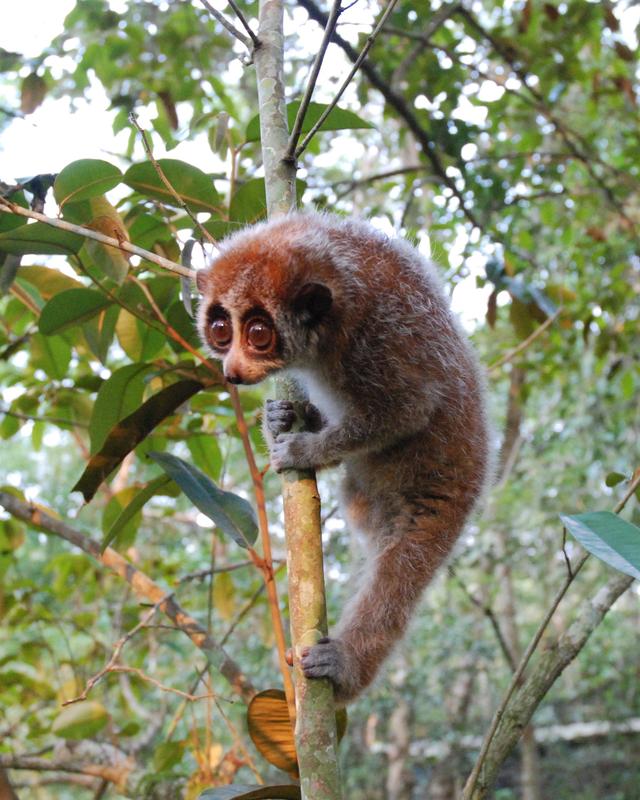First discovery of a hibernating primate outside Madagascar

Pygmy slow loris are the first known hibernating primates outside Madagaskar. Photo: Tilo Nadler
Hibernation is a state of energy conservation during which body temperature and metabolism are drastically reduced. If this state lasts longer than 24 hours, it is called hibernation. Shorter periods are called daily torpor.
There are many mammals that hibernate. However, among primates hibernation is a rare capability, as it had been previously found in three species of lemurs only. Lemurs exclusively live on the island of Madagascar, where they hibernate during the dry season, mainly to conserve water.
Southeast Asian pygmy slow lorises regularly hibernate
Now a team at the Research Institute of Wildlife Ecology at the Vetmeduni Vienna, collaborating with colleagues from the Vietnamese Endangered Primate Rescue Center, has discovered another primate that hibernates: the pygmy slow loris (Nycticebus pygmaeus).
They belong to the so-called wet nosed primates, reach a body size of about 20 centimeter and a body mass of 400 gram. They live in Southeast Asia and are nocturnal, tree-living animals.
The researchers investigated the body temperatures of five pygmy lorises in fall, winter, and spring in a Vietnamese primate reservation. It turned out that both sexes repeatedly showed hibernation episodes lasting up to 63 hours between December and February.
According to first author Thomas Ruf, the underlying reason is likely an endogenous annual clock, which induces hibernation at a time of the year when food abundance is decreasing. However, it is also the decreasing ambient temperature that triggers hibernation.
“In Vietnam, where we studied the animals, there are pronounced seasons. Ambient temperature can drop to 5 centigrade. This is exactly when the probability of animals entering a hibernation episode was highest”, Ruf explains.
According to Ruf, free living pygmy lorises are adapted to reduced food availability in winter. During the cold season food is sparse. Hibernation then helps to save energy. “There had been anecdotal observations of pygmy lorises that remained inactive for several days. Occasionally animals were encountered that felt cool to the touch. However, we discovered only now that the lorises actually hibernate” explains first author Thomas Ruf.
Hibernation as an overwintering strategy among primates
Previously, scientists had assumed that the environmental conditions on Madagascar may have been crucial for the occurrence of hibernation among primates. “Our new finding of a hibernating primate species outside Madagascar sheds new light on the evolution of hibernation”, emphasizes Ruf. “Possibly, hibernation as an overwintering strategy was lost in other primates in Africa, Asia, and the Americas. However, perhaps hibernation is also used by further primate species, which have not been studied yet.”
Service:
The article „Hibernation in the pygmy slow loris (Nycticebus pygmaeus): multiday torpor in primates is not restricted to Madagascar”, by Thomas Ruf, Ulrike Streicher, Gabrielle L. Stalder, Tilo Nadler und Chris Walzer was published in Nature’s Scientific Reports. DOI: 10.1038/SREP17392
http://nature.com/articles/doi:10.1038/srep17392
About the University of Veterinary Medicine, Vienna
The University of Veterinary Medicine, Vienna in Austria is one of the leading academic and research institutions in the field of Veterinary Sciences in Europe. About 1,300 employees and 2,300 students work on the campus in the north of Vienna which also houses five university clinics and various research sites. Outside of Vienna the university operates Teaching and Research Farms. http://www.vetmeduni.ac.at
Scientific Contact:
Ao.Univ.-Prof. Dr. Thomas Ruf
Research Institute of Wildlife Ecology
University of Veterinary Medicine Vienna (Vetmeduni Vienna)
T +43 1 25077-7150
Released by:
Susanna Berger
Science Communication / Corporate Communications
University of Veterinary Medicine Vienna (Vetmeduni Vienna)
T +43 1 25077-1153
susanna.berger@vetmeduni.ac.at
http://www.vetmeduni.ac.at/en/infoservice/presseinformation/press-releases-2015/…
Media Contact
All latest news from the category: Life Sciences and Chemistry
Articles and reports from the Life Sciences and chemistry area deal with applied and basic research into modern biology, chemistry and human medicine.
Valuable information can be found on a range of life sciences fields including bacteriology, biochemistry, bionics, bioinformatics, biophysics, biotechnology, genetics, geobotany, human biology, marine biology, microbiology, molecular biology, cellular biology, zoology, bioinorganic chemistry, microchemistry and environmental chemistry.
Newest articles

Durable, Efficient, Sustainable: The Rise of Cerium Oxide Thermal Switches
Groundbreaking cerium oxide-based thermal switches achieve remarkable performance, transforming heat flow control with sustainable and efficient technology. Cerium Oxide-Based Thermal Switches Revolutionize Heat Flow Control Thermal switches, which electrically control…

How Industrial Robots are Reducing Emissions in Global Manufacturing
A new study explores the intersection of industrial automation and environmental sustainability, focusing on the role of industrial robots in reducing the carbon intensity of manufacturing exports. The research demonstrates…

Patients Can Heal Through Precise, Personalized Bioceramic Grafts
A recent review is transforming the landscape of craniomaxillofacial bone regeneration with the introduction of personalized bioceramic grafts. This pioneering research explores the fabrication and clinical potential of synthetic grafts…



